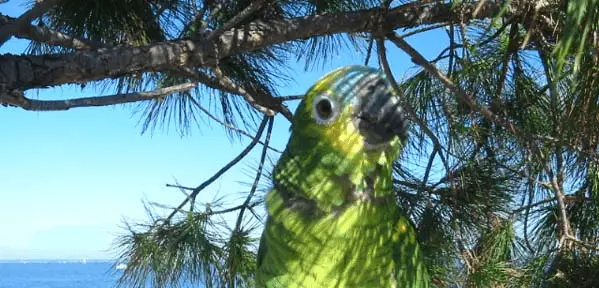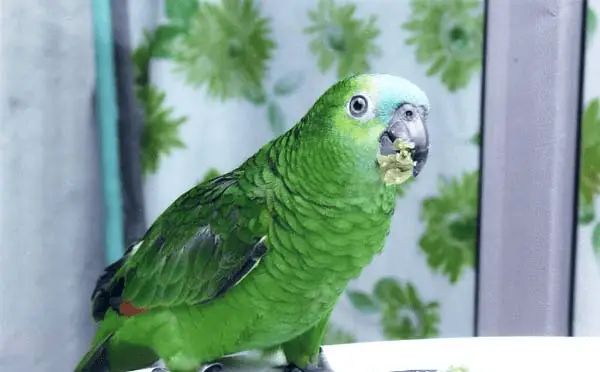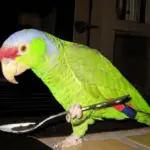
Boris and vitamin A
Boris is a very difficult Amazon. He has been eating only seeds for almost thirteen years now, and he has no way to taste anything else. Except, of course, with mashed potatoes. He cannot resist it. This weakness for the food in question gave rise to an utterly amusing anecdote. One beautiful autumn day, Boris had escaped outside.
He had finished his run on the highest branch of the tree in the fourth neighbor’s backyard. How small he looked at this height! No ladder could reach him there. Despite repeated calls and invitations from Ginette and Roger, he categorically refused to come down, no doubt finding the view very beautiful from up there … His mistress then had a very good idea.
She settled down under the tree, a bowl of mashed potatoes in her hand, pretending to taste it. Her exclamations were heard by the parrot who could not resist the temptation to come and join her in order to participate in the feast too. His gluttony had saved him!
In order not to upset their parrot or make it unhappy, Ginette and Roger willingly bow to their dietary whims. They even go so far as to buy him sunflowers not mixed with other seeds. “It gives Boris less trouble. He doesn’t need to sort them through the other seeds.”
vitamin a deficiency in birds

Boris’s health has always been good, thank goodness. However, for the past month, Boris has not been at his best. A whitish, sticky substance forms inside the parrot’s beak. The area around his eyes and nostrils is stuck with secretions. In addition, ulcers appeared under his paws, which made his movement painful and difficult.
Treatments with different antibiotics were tried, but the result remained mixed although the last therapeutic attempt was based on the results of culture with an antibiogram (culture is a test carried out on an abnormal secretion in order to identify precisely which bacterium is present. The antibiogram is a complementary procedure that consists in determining to which antibiotics this bacterium is sensitive or resistant).
When Boris was introduced to me, he had already lost a lot of weight and his general condition had deteriorated a lot. In addition to his symptoms of infection, a striking clue was present in his beak: The edges of the opening in his choanae were thickened, irregular, and dotted with small white masses. The small, pointed protuberances that normally border this opening had also disappeared.
The diagnosis was clear: severe hypovitaminosis A with a secondary bacterial infection. Boris’ condition improved greatly following the vitamin A injections. The secondary infection subsequently resolved very well with antibiotic therapy. Of course, the parrot diet was the central point of the discussion with Ginette and Roger. No more pure sunflower! Boris is only entitled to his regular grain mixture.
A parrot vitamin and mineral supplement are offered daily. Boris even started to eat the feed! Who would have thought? It was enough to mix with mashed potatoes. Ginette is now busy adding different vegetables to this puree. Patience always rewards.
Vitamin A deficiencies are common in parrots fed exclusively on seeds. Vitamin A is an essential element for the good health of skin cells, mucous membranes of the respiratory, digestive, and urogenital systems to name a few.
Early diagnosis of a deficiency
- Choana papillae absent or atrophied.
- Gram stain of choanae (recommended annually). In addition to bacteria, cells from the choana epithelium are observed. These cells are more angular in shape and stain more intensely in people lacking vitamin A, long before other symptoms appear.
vitamin a deficiency in birds

Abnormal cells in the choanae of a parrot bothered by a chronic lack of vitamin A eventually turn into sterile abscesses. Patches and small white, moist masses are then visible in different places in the bird’s beak, more often on the edges of the choana opening and on the sides of the tongue.
Mucoid material can even accumulate in large quantities and partially block the opening of the trachea to the point of interfering with breathing. To the naked eye, it might look like a primary bacterial infection of the oral cavity and respiratory system. Unfortunately, treatment with antibiotics alone does not solve the problem. Although bacteria secondarily infect this diseased region,
Lack of vitamin A also sometimes causes an abnormal thickening of the skin on the underside of the legs. The elasticity of the skin is greatly altered, it cracks easily. Bacteria secondarily infect the small crevices causing painful ulcers (pododermatitis).
To remember
- In order to prevent deficiencies:
- Encourage the bird to consume good quality feed daily.
- Add a vitamin and mineral supplement to the diet of those who persist in eating only seeds.
- Offer fresh fruits and vegetables every day.
- A feed containing 5,000 to 10,000 IU / Kg of vitamin A meets the needs of the vast majority of parrot species.
- Certain species of parrots have higher requirements for vitamin A: Eclectus, conures, and certain amazons (particularly the blue-fronted Amazon).
- The carotene in food is converted into vitamin A by the body as needed. Yellow or orange vegetables are rich in them.
- An annual examination and a Gram stain of the choanae are invaluable tools in order to detect very early, any change associated with a deficiency.
Vitamin a deficiency in birds
SOURCE:Denny the Budgie




















